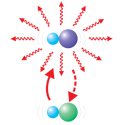May cooler molecules prevail
Researchers have successfully used laser techniques to produce molecules at temperatures below one millikelvin, but only if the constituent atoms are cooled first and then form molecules. Unfortunately, only molecules made of two alkali atoms are amenable to this technique and then, only in limited quantities. Laser cooling of an already-formed molecule would tap into a wider range of species, but cooling tends to be blocked when the molecules are sidetracked into unwanted rotational and vibrational states. Now, Edward Shuman, John Barry, David Glenn, and David DeMille of Yale University in the US report in Physical Review Letters an optical technique that can suppress undesirable rotational and vibrational decays in strontium monofluoride.
Molecular cooling requires optical cycling—repeated nudges created by absorptions of photons and radiative decays in a closed loop. In strontium monofluoride, the vibrational levels in the excited electronic state are overwhelmingly likely to transition to states with the same vibrational quantum number in the ground state, and with only one or two extra “repumping” lasers, it is possible to keep the molecules from straying out of the optical cooling cycle. The Yale group eliminated the occupation of unwanted rotational levels by a similarly careful choice of states, but molecules can also get lost in “dark” states, so they solved this by applying a small magnetic field. The researchers apply their technique to a molecular beam of strontium monofluoride and report a clear fluorescence signal from the optical cycling and a deflection of the beam from the induced radiative force, opening the way for direct laser cooling of this and similar molecular species. – David Voss





